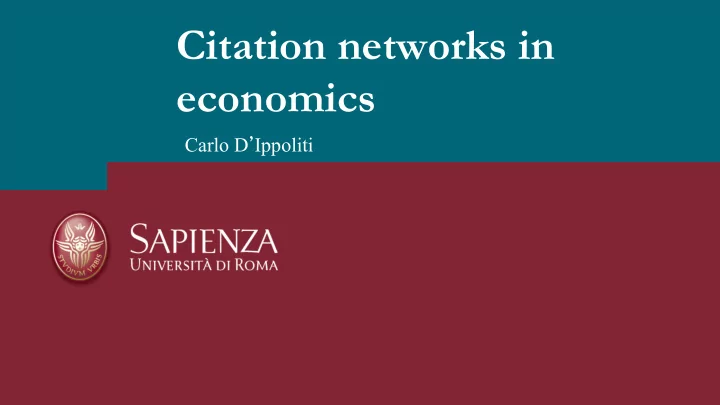

Citation networks in economics Carlo D ’ Ippoliti Carlo D ’ Ippoliti – Citation Networks in Economics Edinburgh, INET 2017
The most hierarchical social science Source: Fourcade et al. (JEP, 2015) Carlo D ’ Ippoliti – Citation Networks in Economics Edinburgh, INET 2017
The “superiority of economists” Source: Fourcade et al. (JEP, 2015) Carlo D ’ Ippoliti – Citation Networks in Economics Edinburgh, INET 2017
The “superiority of economists” Source: Fourcade et al. (JEP, 2015) Carlo D ’ Ippoliti – Citation Networks in Economics Edinburgh, INET 2017
Over the top Source: Colussi (RES, 2017) Carlo D ’ Ippoliti – Citation Networks in Economics Edinburgh, INET 2017
Citations: skewed, biased, and widely used • indexes based on citations are applied to the evaluation of individuals, journals, departments, universities, and even whole countries • citation counts correlate with: – at the publication level: number and reputation of authors, publication age, language, kind of publication, reputation of the journal, number of pages, title length; – at the author level: academic age, field and degree of specialization, and gender. • Systematic differences across and within disciplines, self-citations, selective/implicit citations, citations inflation, etc. – h index is not robust to even trivial changes in the papers or citation counts Carlo D ’ Ippoliti – Citation Networks in Economics Edinburgh, INET 2017
Source: Oswald (2007) Carlo D ’ Ippoliti – Citation Networks in Economics Edinburgh, INET 2017
Simply the best? Italian economists in Web of Science, 2011-2016 Carlo D ’ Ippoliti – Citation Networks in Economics Edinburgh, INET 2017
Productive and ceremonial motivations • “we didn’t want to be told we had neglected to cite certain people. So there are people in here, for example, X is one of these people we anticipated being a referee ” (quoted in White and Wang, 1997, p. 145) • “[i]n economics there are all different kinds of levels of journals, and the theoretical level that we were aiming at is most closely matched by the Journal of Economic Theory , Review of Economic Studies , and Econometrica . The paper that we actually wrote was ultimately submitted to Econometrica . So, when we picked out references, we tried to stay in that group. It is a little bit of gamesmanship in a way, to be citing the right people ” (ibid., p. 136) Carlo D ’ Ippoliti – Citation Networks in Economics Edinburgh, INET 2017
Citations don’t count: they are counted Carlo D ’ Ippoliti – Citation Networks in Economics Edinburgh, INET 2017
The case of Italy • 948 economists with tenure in an Italian university in 2011-2016 – 439 have at least one paper in “economics” in Web of Science. They were cited 1969 times, of which 621 times by at least another economist in the sample – 142 economists cited and 151 were cited by another economist in the sample • For each pair of authors, I collected: – Measures of proximity : co-authorship (number of jointly written papers) and the number of common institutional affiliations – Measures of similarity : the number of journals in which both published, and the cosine similarity of the metadata of all papers written up to time t – Measure of common ideology : the number of newspapers, magazines (68) and blogs (10) in which both gave an interview or wrote an article Carlo D ’ Ippoliti – Citation Networks in Economics Edinburgh, INET 2017
Network Formation: probability of dyadic citations Carlo D ’ Ippoliti – Citation Networks in Economics Edinburgh, INET 2017
Odds ratios 6 549% 5 4 331% 3 224% 2 171% 107% 1 0 Same Co-authors Same Similar Same media journal(s) affiliation(s) topics Carlo D ’ Ippoliti – Citation Networks in Economics Edinburgh, INET 2017
Mean Std. Dev. Citation link 0,11% 0,04 Journal link 2,98% 0,25 Co-authorship link 0,23% 0,06 Affilitations link 1,42% 0,12 Topics similarity 4,31% 0,07 Media outlets link 2,58% 0,56 Carlo D ’ Ippoliti – Citation Networks in Economics Edinburgh, INET 2017
Citations per author: Poisson Pseudo-ML Carlo D ’ Ippoliti – Citation Networks in Economics Edinburgh, INET 2017
Closeness centrality: incidence rate ratios 400% 350% 300% 250% 200% 150% 100% 50% 0% Media Co-authorship Affiliations Journals Topics Carlo D ’ Ippoliti – Citation Networks in Economics Edinburgh, INET 2017
Scientific = perfunctory ? Henk Moed (2005, p. 219): “In any field there are leading groups active at the forefront of scientific development. Their leading position is both cognitively and socially anchored . Cognitively, their important contributions tend to be highlighted in a state-of-the-art of a field. But to the extent that the science system functions well in stimulating and warranting scientific quality, leading groups, and particularly their senior researchers, tend at the same time to acquire powerful social positions.” Carlo D ’ Ippoliti – Citation Networks in Economics Edinburgh, INET 2017
Carlo D ’ Ippoliti – Citation Networks in Economics Edinburgh, INET 2017
Recommend
More recommend